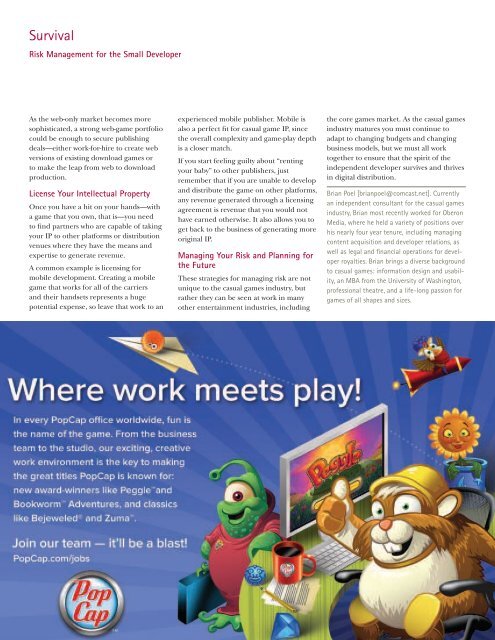Download .pdf - magazine & cover archive - Casual Connect
Download .pdf - magazine & cover archive - Casual Connect
Download .pdf - magazine & cover archive - Casual Connect
Create successful ePaper yourself
Turn your PDF publications into a flip-book with our unique Google optimized e-Paper software.
Survival<br />
Risk Management for the Small Developer<br />
As the web-only market becomes more<br />
sophisticated, a strong web-game portfolio<br />
could be enough to secure publishing<br />
deals—either work-for-hire to create web<br />
versions of existing download games or<br />
to make the leap from web to download<br />
production.<br />
License Your Intellectual Property<br />
Once you have a hit on your hands—with<br />
a game that you own, that is—you need<br />
to find partners who are capable of taking<br />
your IP to other platforms or distribution<br />
venues where they have the means and<br />
expertise to generate revenue.<br />
A common example is licensing for<br />
mobile development. Creating a mobile<br />
game that works for all of the carriers<br />
and their handsets represents a huge<br />
potential expense, so leave that work to an<br />
experienced mobile publisher. Mobile is<br />
also a perfect fit for casual game IP, since<br />
the overall complexity and game-play depth<br />
is a closer match.<br />
If you start feeling guilty about “renting<br />
your baby” to other publishers, just<br />
remember that if you are unable to develop<br />
and distribute the game on other platforms,<br />
any revenue generated through a licensing<br />
agreement is revenue that you would not<br />
have earned otherwise. It also allows you to<br />
get back to the business of generating more<br />
original IP.<br />
Managing Your Risk and Planning for<br />
the Future<br />
These strategies for managing risk are not<br />
unique to the casual games industry, but<br />
rather they can be seen at work in many<br />
other entertainment industries, including<br />
the core games market. As the casual games<br />
industry matures you must continue to<br />
adapt to changing budgets and changing<br />
business models, but we must all work<br />
together to ensure that the spirit of the<br />
independent developer survives and thrives<br />
in digital distribution.<br />
Brian Poel [brianpoel@comcast.net]. Currently<br />
an independent consultant for the casual games<br />
industry, Brian most recently worked for Oberon<br />
Media, where he held a variety of positions over<br />
his nearly four year tenure, including managing<br />
content acquisition and developer relations, as<br />
well as legal and financial operations for developer<br />
royalties. Brian brings a diverse background<br />
to casual games: information design and usability,<br />
an MBA from the University of Washington,<br />
professional theatre, and a life-long passion for<br />
games of all shapes and sizes.<br />
Rapid Prototyping to the Rescue<br />
How to Keep Design Documents from Destroying Innovation<br />
In the last 18 months, it has become rare<br />
to hear someone say “prototyping” without<br />
it being adjacent to either the word “rapid”<br />
or “iterative,” or (for that matter) “rapid<br />
iterative.” I see that “rapid prototyping”<br />
generates about 1.6 million Google hits,<br />
whereas there are exactly 589 for “slow<br />
prototyping.” The prototypers have spoken.<br />
During the development of our game<br />
Schizoid, we accumulated more evidence<br />
(the hard way) that rapid prototyping is<br />
the best method of creating innovative<br />
game-play. This was not surprising. But at<br />
the same time, we also found (probably<br />
belatedly) that there’s a second reason<br />
that speedy rapid prototyping is important:<br />
Speed saves prototypes—and in turn,<br />
therefore, it can save projects. (If “speedy<br />
rapid prototyping” sounds redundant,<br />
a more detailed description might be<br />
“rapidly-iterative prototyping that quickly<br />
proves its point.”)<br />
Design Documents Stifle Innovation<br />
I don’t think I’ve talked to any developer<br />
in the past five years who has said that<br />
the key to innovative game development<br />
is writing—and then executing—a thick,<br />
monolithic game design document. In<br />
contrast, the buzzwords—actually buzzbullet-points—I’ve<br />
heard in the last couple<br />
of years have been:<br />
• Try a tiny prototype to investigate a new<br />
game-play idea. If it’s fun, plan tentatively<br />
An early prototype of Schizoid<br />
to use it, and polish it up and improve<br />
it a little bit next week. Repeat until<br />
you get Peggle. If the idea isn’t fun, then<br />
either make it more fun in the next week<br />
and try again, or throw it away and try<br />
something else; you have avoided a path<br />
to boredom, and it didn’t cost you much<br />
to learn to avoid that path.<br />
• Agile development methods like<br />
Scrum are really good for this. Work<br />
in short sprints, making immediate<br />
adjustments to the previous day’s work,<br />
and operating off of a two-page to-do list.<br />
And you should adopt this philosophy<br />
of embracing frequent change, using a<br />
rapid-prototyping philosophy on most<br />
components of your game project, for<br />
nearly the entire time you are developing<br />
the game, up until you really freeze the<br />
features and go into final QA.<br />
• You can’t design the fun of a video game<br />
in advance on paper. As you create<br />
parts of the game, unexpectedly fun<br />
interactions will appear occasionally. The<br />
team should pounce on these—because<br />
each unexpectedly fun part of the game<br />
might expand to be a larger part of the<br />
game, or even end up being the focus of<br />
the whole game.<br />
These are the now-standard arguments<br />
on how to innovate in games. Each has<br />
significant downsides. From the viewpoint<br />
of trying to create an innovative game, the<br />
worst downside is that as an independent<br />
game developer,<br />
it’s generally<br />
not possible<br />
to do any of<br />
the above.<br />
For the past<br />
15 years,<br />
publishers<br />
have<br />
required<br />
that thick,<br />
monolithic<br />
design<br />
document<br />
(as opposed<br />
to Design<br />
Bill Dugan<br />
<strong>Casual</strong> <strong>Connect</strong> Magazine <strong>Casual</strong> <strong>Connect</strong> Magazine<br />
“<br />
Risk Management<br />
Speed saves prototypes,<br />
and in turn, therefore,<br />
it can save projects.<br />
”<br />
By Rapid Prototyping) for several wellintentioned<br />
reasons:<br />
• A publisher wants to force you to think<br />
through the consequences of your design<br />
decisions. By writing down the details of<br />
the scoring system before you’ve started<br />
coding, you may realize, for example,<br />
that the scoring system requires the<br />
Reflex Detector system, which you forgot<br />
to write into the schedule. (Even so, I’d<br />
argue that designing the scoring system<br />
up front is a pure waste of time since at<br />
design-doc time it’s not even clear what<br />
the score should measure.)<br />
• The publisher simply wants to see and<br />
understand what it is paying for. “Is this<br />
game we’re buying more like Doom 3,<br />
or Castle Wolfenstein 1 (on the Apple II<br />
version)?”<br />
• The producer has a sneaking suspicion<br />
that you are planning to pocket threequarters<br />
of the advances and use the<br />
remaining one-quarter to pay one<br />
subcontractor and a few college interns<br />
to slap together a game that’s barely<br />
sufficient to satisfy the milestone<br />
definitions. The big design document<br />
may protect against this, the producer<br />
hopes, and robustly!<br />
Another aspect of the thick design<br />
document that affects innovation is this:<br />
The publisher usually tries to incorporate<br />
that document into your contract. When<br />
stuff from the design document gets<br />
changed, simplified, or—horrors!—cut<br />
altogether, a cranky individual at the<br />
publisher can (and probably will) point to<br />
the contract, explain that you are in breach,



